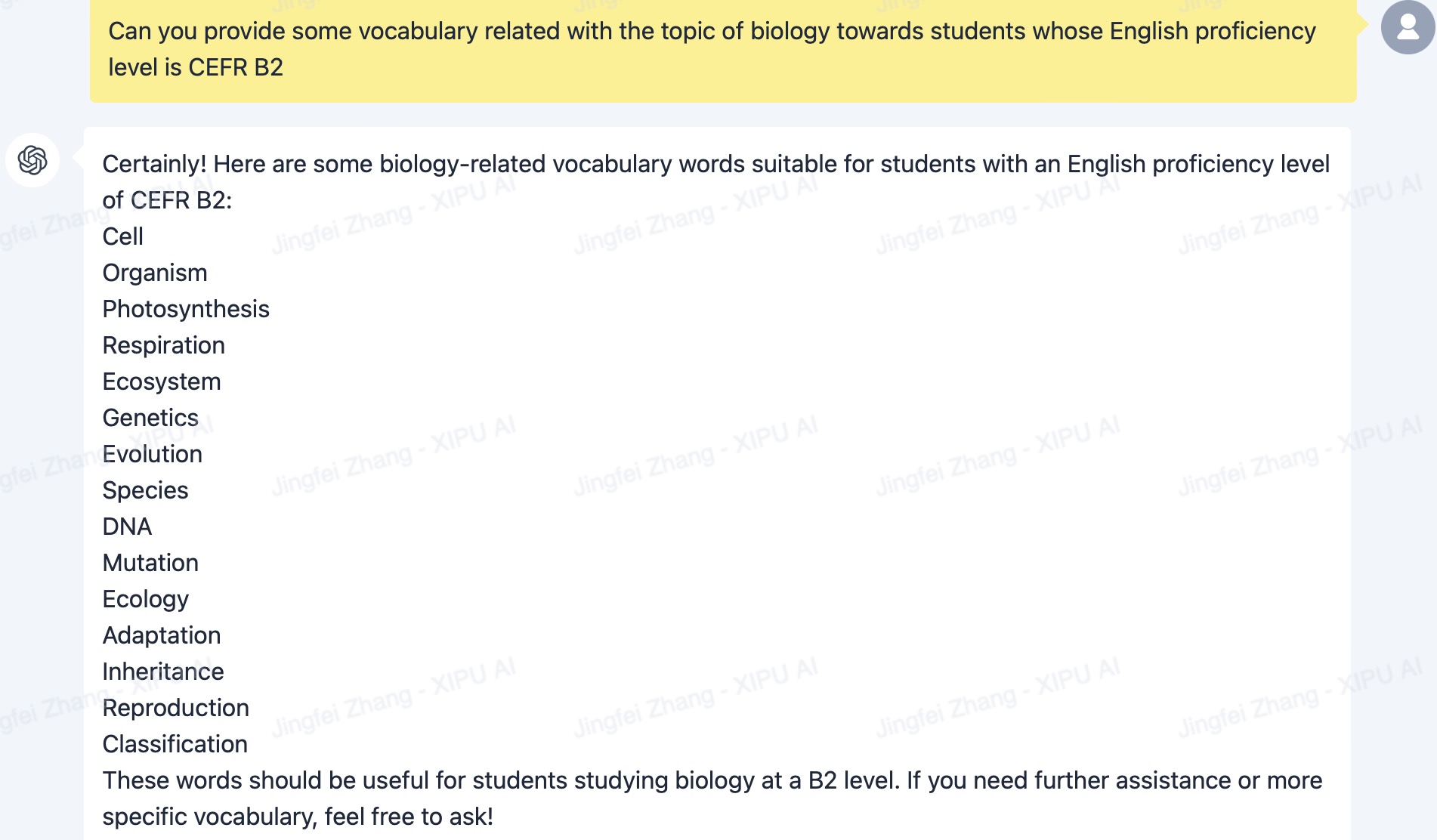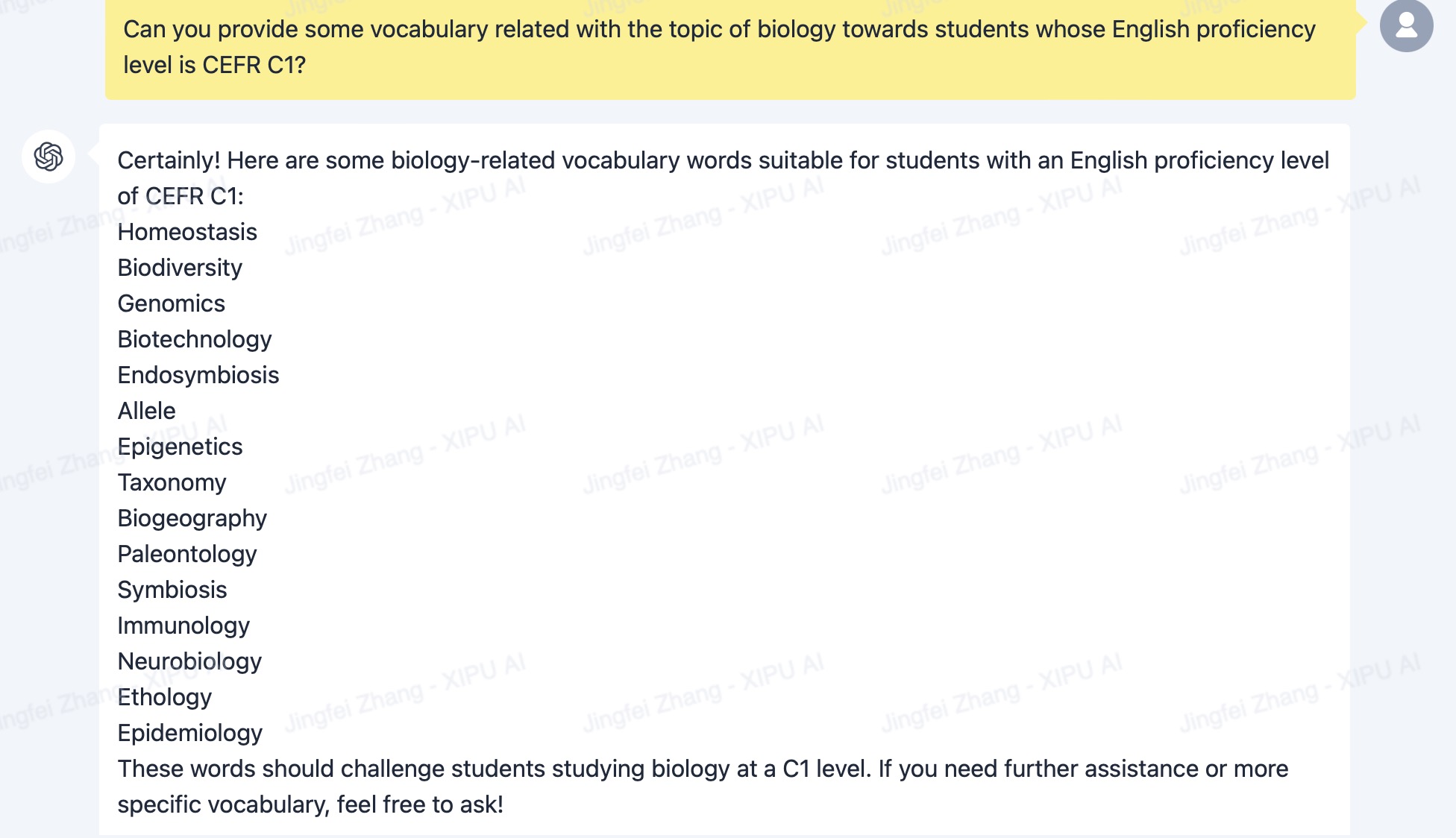Vocabulary acquisition poses a significant challenge in language learning, particularly in the context of English for Academic Purposes (EAP). The constraints of time, intensity, and assessment-centric approaches in EAP courses often lead to neglect of comprehensive vocabulary teaching. Consequently, many students exhibit insufficient vocabulary proficiency, attributable to low initial English levels, reliance on rote learning methods, limited exposure to contextualized vocabulary, and deficiencies in self-discipline and time management. Addressing these challenges, this paper advocates for the integration of Xipu AI into EAP vocabulary instruction as a means to stimulate students’ motivation and improve vocabulary retention.
Background:
Vocabulary acquisition is a fundamental component of language learning. Nevertheless, fostering students' engagement with new words while aiding their retention is extremely difficult. EAP courses, due to their intensive, time-constrained and assessment-based nature, often neglect comprehensive vocabulary instruction. This neglect contributes to the observable inadequacies in students’ vocabulary repertoire within EAP settings. These inadequacies stem from multiple factors:
- Students’ initial English level is relatively low.
- Students habitually rely on rote memorization, impeding their exposure to vocabulary within meaningful contexts and diminishing their motivation to memorize new words.
- Students tend to lack self-discipline and time management skills.
In order to stimulate students’ motivation and enhance their vocabulary retention, XIPU AI is incorporated into vocabulary teaching in my EAP classes. This could also ease the preparatory workload burden on educators.
Using XIPU AI to enhance vocabulary teaching.
- Instead of instructing students to directly match words with corresponding vocabulary, my pedagogical approach involves the preparation of images and contextual frameworks to facilitate vocabulary memorization. By presenting images, students effortlessly associate them with the corresponding vocabulary, while contextual frameworks deepen their understanding of how to use these words appropriately. Furthermore, as shown in Figure 1, I switched the mode to “generate images” so that XIPU AI can produce the pictures based on the key elements described, enhancing the visual representation of vocabulary.
Figure 1 The function of “generate images”
Similarly, XIPU AI automates context generation when prompted with requests such as, “Could you make a sentence by using the vocabulary XXX?”. As demonstrated in Figure 2, this was exemplified in a classroom scenario where XIPU AI generated both pictures and sentences for nine newly acquired vocabulary words, fostering a comprehensive understanding of their usage.
Figure 2 Match words with pictures/contexts
- Apart from comprehending the meanings of target words, I normally provide students with opportunities to apply vocabulary in meaningful contexts. I sometimes divide students into several groups, each tasked with creating logical sentences using assigned words. I also used the technology “wheel decide” to engage students by spinning the vocabulary wheel and linking word wheel so that students need to connect words for sentence construction based on the meaning of the linking word. Subsequently, students use XIPU AI to evaluate the accuracy of their sentences, ensuring both grammatical correctness and contextual appropriateness. Here are two examples from my students:
Figure 3 Use XIPU AI to check sentences
An alternate approach involves providing suggested answers by instructing XIPU AI to create sentences using specific words. This comparative analysis allows students to assess the appropriateness of their responses to those generated by the AI.
- To encourage students to use vocabulary in conversational practices, especially in large classes where individualized attention is challenging, XIPU AI facilitates dialogues with students using target words. For instance, after learning the targeted vocabulary and students need more practice in using these words, they can ask XIPU AI to have a conversation with them. Here is an example from my student:
Figure 4 A conversation with XIPU AI
As demonstrated in Figure 4, XIPU AI smoothly communicated with students in the appropriate scenario. In addition, the answers generated by XIPU AI contained the words that students wanted to practice. In this way, students can not only get the opportunity to practice the target vocabulary but also comprehend how to use all three words in the sentences meaningfully. Without teachers’ supervision, this is especially helpful in developing students’ independent learning skills and learner autonomy during their spare time.
- Another scenario in which I employed XIPU AI was to generate topic-related vocabulary based on students’ language proficiency levels. For example, when introducing the topic of biology, I asked students to brainstorm some topic-related vocabulary. Subsequently, I supplemented their contributions by incorporating additional vocabulary related to this topic. The reason behind this is that in the marking descriptor of writing and speaking, students are asked to use topic-related vocabulary to achieve higher scores in their vocabulary column. As a result, I asked XIPU AI to generate a vocabulary that aligned with the proficiency levels of the students, ensuring that the selected words strike an appropriate balance, neither being excessively challenging nor overly simplistic [figure 5].


Figure 5 Vocabulary related to the topic of “biology”
I also employed this strategy when prompting students to engage in paired discussions centered around a designated topic during warm-up activities. For instance, when introducing the topic of “travel”, I would like students to share their travel experiences. As a result, I asked XIPU AI to generate some vocabulary related to the topic of “travel” tailored to students whose English proficiency level is CEFR B1 [figure 6]. Students were asked to work in pairs and took turns to share their travel experiences. When they were describing, they were asked to use the following topic-related vocabulary. Their partner would put a tick if they heard the following nine words from the utterances.
Figure 6 Vocabulary related to the topic of “travel”
Since XIPU AI can select vocabulary based on students’ language proficiency, I also use it when seeking to supplement vocabulary for students in reading/listening. Below is an example I used for different levels of students [figure 7]. As depicted, XIPU AI chose proper vocabulary for students with different levels of English proficiency.
Figure 7 Selecting vocabulary based on students’ language level.
Conclusion
The integration of XIPU AI into vocabulary teaching arouses students’ motivation and facilitates the memorization of new vocabulary since students can not only comprehend the meaning of words but also apply them in meaningful contexts. Furthermore, XIPU AI contributes to the cultivation of students' learning autonomy, as they can employ it to assess the accuracy of their vocabulary usage and engage in conversations with XIPU AI. Apart from the advantages for students, teachers can reduce their preparation time and efficiently select vocabulary based on the appropriate proficiency level.
Notes:
CEFR refers to the Common European Framework of Reference for Languages, which provides a comprehensive framework for assessing language proficiency. Here is a table to illustrate the relationship between CEFR level and vocabulary size.











